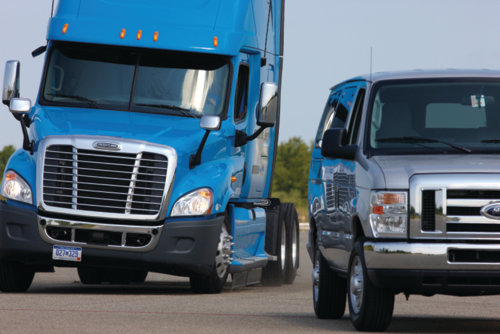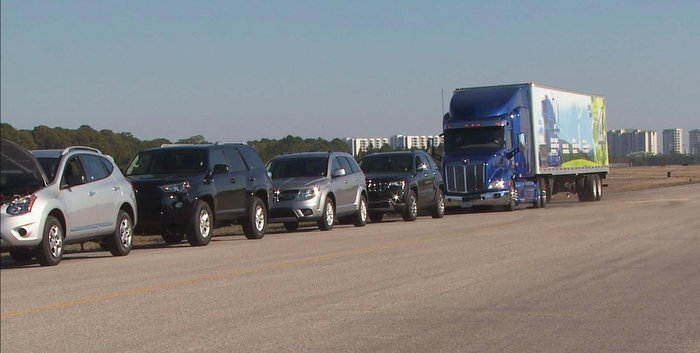Detroit Assurance systems are based on the truck’s position and movement and use cab-mounted radar and cameras to warn the driver or, if necessary, slow the truck down automatically. The Adaptive Cruise Control (ACC) is paired with the ABA in the Detroit Assurance, allowing the ACC to automatically adjusts the truck’s cruising speed to maintain a safe following distance from other vehicles in its path, allowing the truck to remain in cruise control longer. While in cruise control mode, the system sets the cruise speed to ensure a safe following distance to the vehicle ahead. The factory setting is 3.5 seconds behind the forward vehicle. As the truck approaches the slower vehicle from behind, the truck will slow to maintain a speed that ensures that 3.5-second safe distance. Once the vehicle clears, the truck will resume the faster cruise speed. If a vehicle abruptly enters the lane, ACC will attempt to adjust to the situation, and the system will be employed if necessary.
Detroit Assurance’s lane departure warning (LDW) is an optional independent system that is only available in addition to the radar system. When the truck exceeds 37 MPH, the system uses a camera to track the truck’s position and provide warnings if the truck veers out of its lane. The forward-facing camera is specially built to detect reflective paint and raised reflectors in road lines. However, if lines are faint, or covered by snow or dirt, the LDW system may not activate. For situations such as highway construction or winding roads, the system can be disabled with a switch on the instrument pane and then automatically re-engage at 48 MPH. The LDW camera never faces or records the driver.
“The full integration of Detroit Assurance, a Detroit engine and the Detroit DT12 AMT results in smoother and more fuel-efficient speed and braking transitions,” said Mary Aufdemberg, director of product marketing for Freightliner Trucks. “Detroit Assurance is making good drivers even better by extending their ability to react to uncertainty on the road. We anticipate wider safety system adoption in coming years as additional features are developed, like pedestrian recognition, cross-traffic recognition and blind spot recognition.” Detroit Assurance is available for the Freightliner Cascadia Evolution and Cascadia equipped with Detroit engines.

Meritor WABCO OnGuard
Meritor WABCO’s OnGuard, a radar-based active safety system, offers Collision Mitigation and Adaptive Cruise Control (ACC) with Active Braking. The system uses forward-looking radar sensor technology to monitor the distance to a moving vehicle ahead. If it detects that a potential collision is developing, it responds by sending warnings, automatically reducing engine speed and applying foundation brakes. ACC assists in maintaining a 3.6 second interval between driver’s vehicle and the vehicle ahead.
The OnLane Lane Departure Warning System with SafeTraK technology by Takata from Meritor WABCO is a camera-based system that helps avoid unintentional lane drifting. The system utilizes a camera mounted near the top center of the windshield to monitor and calculate a vehicle’s position within the lane. When OnLane detects that a vehicle is crossing lane markings without the turn signal being activated, the system sounds an audible warning.
Another offered OnLane option provides the ability to record and save videos of critical safety events. Along with SmartDrive Systems, the company is offering ProView, a video-based analysis and personalized driving performance improvement program that features predictive analytics. Fleet managers can access the video through SmartDrive’s web-based application and drivers can access the video through a smartphone app.
WABCO also offers the ProView solution, which uses advanced analytics to identify and capture risks in real time from a range of on-board systems and sensors. The system triggers camera recordings, offloads that video and provides a managed service that scores and prioritizes those videos for the fleet.
“Heavy-duty truck fleets using WABCO’s OnGuard collision mitigation system have reported a 65-87% reduction in accidents, resulting in an up to 89% reduction in accident costs compared to vehicles without OnGuard,” said Jon Morrison, president of WABCO Americas. “With the introduction of OnGuardACTIVE, we anticipate the benefits to improve further due to the system’s ability to extend crash mitigation by actively braking on stationary vehicles and performing well in all seasons.”














